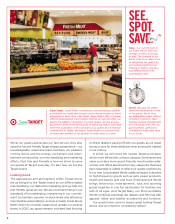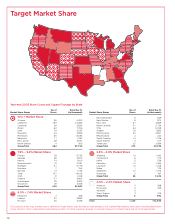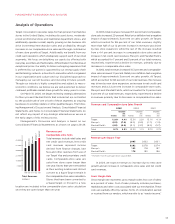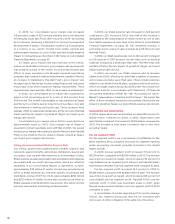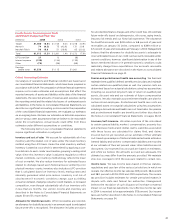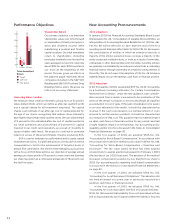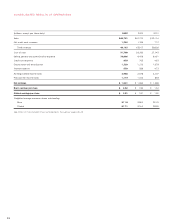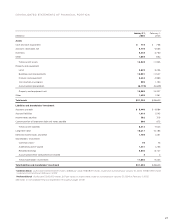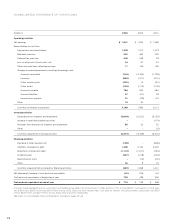Target 2003 Annual Report Download - page 20
Download and view the complete annual report
Please find page 20 of the 2003 Target annual report below. You can navigate through the pages in the report by either clicking on the pages listed below, or by using the keyword search tool below to find specific information within the annual report.
18
In 2003, our consolidated gross margin rate increased
0.5 percent to a rate of 32.0 percent primarily due to the adoption
of Emerging Issues Task Force (EITF) Issue No. 02-16 “Accounting
by a Customer (Including a Reseller) for Certain Consideration
Received from a Vendor.” The adoption resulted in a reclassification
of a portion of our vendor income from selling, general and
administrative expenses to cost of sales and had a slight negative
impact on net earnings as described in the Notes to Consolidated
Financial Statements on page 30.
At Target, gross margin rate improved due to the vendor
income reclassification. Mervyn’s gross margin rate improvement
was primarily a result of the vendor income reclassification and
efforts to lower purchase costs through improved negotiating
programs that resulted in markup improvement, partially offset by
an increase in markdowns. Marshall Field’s gross margin rate
increased due to the vendor income reclassification and reductions
in purchase costs which resulted in markup improvement. These
improvements were partially offset by an increase in markdowns.
In 2002, our consolidated gross margin rate expanded by
almost a full percentage point to a rate of 31.5 percent from
30.6 percent. The growth is attributable to rate expansion at Target
and Mervyn’s, primarily due to reductions in purchase costs and
improvements in markup during the year. These increases were
partially offset by additional markdowns at Mervyn’s and Marshall
Field’s and the mix impact of growth at Target, our lowest gross
margin rate division.
Consolidated gross margin rate in 2004 is expected to be
approximately equal to 2003. Gross margin rate at Target is
expected to remain essentially even with that of 2003. We expect
modest gross margin rate expansion at both Mervyn’s and Marshall
Field’s to be offset by the mix impact of faster growth at Target,
our lowest gross margin rate division.
Selling, General and Administrative Expense Rate
Our selling, general and administrative (SG&A) expense rate
represents payroll, benefits, advertising, distribution, buying and
occupancy, start-up and other expenses as a percentage of sales.
SG&A expense excludes depreciation and amortization and expenses
associated with our credit card operations, which are reflected
separately in our Consolidated Results of Operations. In 2003,
approximately $78 million of vendor income was recorded as an
offset to SG&A expenses as it met the specific, incremental and
identifiable criteria of EITF No. 02-16. Approximately $294 million
and $272 million of vendor income was recorded as an offset to
SG&A expenses in 2002 and 2001, respectively. This vendor income
primarily represented advertising reimbursements.
In 2003, our SG&A expense rate increased to 22.9 percent
compared to 22.0 percent in 2002. Over half of this increase is
attributable to the reclassification of vendor income to cost of sales
from SG&A expenses as described in the Notes to Consolidated
Financial Statements on page 30. The remaining increase is
principally due to a lack of sales leverage at both Mervyn’s and
Marshall Field’s.
In 2002, our SG&A expense rate rose to 22.0 percent compared
to 21.6 percent in 2001 because certain items such as medical
expenses increased at a faster pace than sales. This effect was only
partially offset by the mix impact of growth at Target, our lowest
SG&A expense rate division.
In 2004, we expect our SG&A expense rate to increase
slightly from 2003, reflecting our belief that a number of expenses
will increase at a faster pace than sales. These include expenses
related to our defined benefit plans, insurance and stock options,
which we began expensing during 2003 under the prospective
transition method in accordance with Statement of Financial
Accounting Standards (SFAS) No. 148, “Accounting for Stock-
Based Compensation—Transition and Disclosure.” We expect the
effect of these increased expenses to be partially offset by the mix
impact of growth at Target, our lowest SG&A expense rate division.
Depreciation and Amortization
In 2003, depreciation and amortization increased 8.9 percent to
$1,320 million compared to 2002. In 2002, depreciation and
amortization increased 12.4 percent to $1,212 million compared to
2001. The increase in both years is primarily due to new store
growth at Target.
Pre-tax Segment Profit
Pre-tax segment profit is our core measure of profitability for the
three segments and is a required disclosure for segment reporting
under accounting principles generally accepted in the United
States (GAAP).
In 2003, pre-tax segment profit increased 7.9 percent to
$3,734 million, compared with $3,461 million in 2002. The increase
was driven by growth at Target, which produced 93 percent of
consolidated pre-tax segment profit. Mervyn’s and Marshall Field’s
experienced a decrease in pre-tax segment profit compared to 2002.
Pre-tax segment profit increased 16.7 percent in 2002 to
$3,461 million, compared with $2,965 million in 2001. The increase
was driven by growth at Target, which produced 89 percent of
consolidated pre-tax segment profit. Marshall Field’s pre-tax
segment profit in 2002 was essentially equal to 2001, while
Mervyn’s experienced a decline in pre-tax segment profit in 2002
compared to 2001.
A reconciliation of pre-tax segment profit to pre-tax earnings
follows. Our segment disclosures may not be consistent with
disclosures of other companies in the same line of business.


